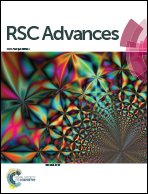A real-time colorimetric and ratiometric fluorescent probe for rapid detection of SO2 derivatives in living cells based on a near-infrared benzopyrylium dye†
Abstract
A benzopyrylium-based dye, Probe 1, was developed as a near-infrared fluorescent probe for the detection of SO2 derivatives (sulfite/bisulfite) in pure aqueous solution. In the presence of sulfite/bisulfite, the solution of Probe 1 displayed significant changes in its absorption (from 650 nm to 420 nm) and emission (from 690 nm to 489 nm) spectra. Probe 1 exhibits excellent selectivity and high sensitivity toward sulfite/bisulfite and the detection limit (S/N = 3) for bisulfite is as low as 10.4 nM. Specifically, Probe 1 shows a fast response time (within 10 s) toward sulfite/bisulfite, which makes it capable for real-time sensing or imaging both in vitro and in vivo assays. Probe 2, an analogue of Probe 1, as a turn-on fluorescent probe was also developed and displayed similar properties for the detection of sulfite/bisulfite. The demonstration of Probe 1 as a ratiometric fluorescent probe and Probe 2 as a turn-on fluorescent probe for the detection of SO2 derivatives was achieved in living HeLa cells and A431 cells, respectively.


 Please wait while we load your content...
Please wait while we load your content...